One of the most significant components of a car is the “Brake Disc”. It has a crucial role in controlling the car.
For this reason, installing a top-quality brake disc can enhance the immunity system of your car, as a defective disc can cause car accidents.
That will cause the driver to lose control of the car. The brake disc may physically look basic, but in the case of its absence, serious circumstances may come across.
Note that this vital component’s average life stands at 50,000 miles. A brake disc is a round component that has a direct interaction with two other parts:
1. Wheels
Brake discs spin along with the wheels when the car is turned on.
2. Brake pads
Brake pads contain two different parts:
- The steady surface
- The in-friction surface
The functional mechanism of brake discs, brake pads, and wheels begins when the driver pushes his feet on the brake pedals, the brake pads conflict with the brake discs and decelerate the discs spinning. As a result, it decelerates the wheel spinning and makes the car stop.
Another name for this component is the Wheel disc, and it’s round-shaped because it should be located between the wheels and the brake pads.
This component is made of aluminum, steel, cast iron, or iron so that the brake pad can cause friction on the brake disc. Other parts of this component are the brake caliper and the main cylinder. The two sides of the brake disc are mechanized, and it’s maintained by two screws and a central bead at the intended area. The disc is usually made of cast iron or ceramics.
Brake Disc Types
Brake discs fall into two categories:
1. Flat discs
2. Ventilated discs
Flat discs are designed in a straightforward way, and the exterior surface is also plain and polished. However, ventilated discs are designed in different ways. You can find some examples below.
Of course, some brakes contain an interior conditioner, which do not require ventilated discs. That’s why you may run into some simple discs that have a conditioner system.
Flat Brake Disc: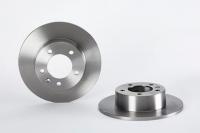
These types of discs are called the flat ones, as they are thoroughly plain and polished. They are mainly made of iron, which does not have a high thermal coefficient. That’s why those cars which use this kind of brake disc do not have high efficiency.
The heat in the mentioned discs is simply increased, especially in the cars without the APS brake. These discs are also called “Solid discs” because they are nothing but iron-filled surfaces.
Ventilated Discs :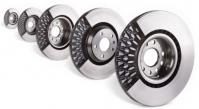
Nowadays, a ventilated disc is used more. The way they are designed, make them extract the heat. That’s because of their designed mechanism. Whilst designing the brake disc, the two surfaces are divided and made into a stilted surface. This factor will enable them to install ventilated channels within the surfaces.
The act of auto-ventilation of the disc will ventilate the caliber as well and will cause better braking functionality, reducing the probability of cracking. .
The driver will no longer need to stop the car so that the disc rests a bit. Recently, the knowledge of the disc air release has improved a lot. This has resulted in manufacturing different types, which we can call:
- Drilled discs
- Slotted/Grooved Brake Discs
- Combination of Slotted / Drilled Brake Discs
- Waved Edge Brake Discs
Drilled Discs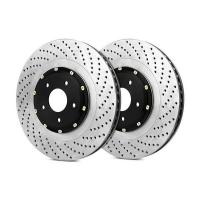
These discs contain a bunch of hollows. These drills are made to: 1. Heat outflow caused by the contact between the brake and pads 2. Outflow of the gas made by the brake pads whilst driving (as these gasses produce an additional layer on the disc that reduces the contact between the disc and the brake pads) In general terms, the holes in this kind of disc transfer the heat, gas, and water to the outside and make the brake function to the fullest. However, these drills may lessen the stability of the discs as well. For instance, making a hole in the wall lessens the solidity of the wall. It’s worth knowing that nowadays, the alloy used to make the discs is steadier, but still, a consequent driving with high velocity will increase the probability of the disc braking.
Slotted/Grooved Brake Discs
It is crystal clear that these discs are designed with corrugations which enable them to transfer the gas, heat, and water to the outside. These corrugations act as channels to guide the junk materials (made out of the conjunction of brake pads and discs) to the outside. This kind of disc is usually installed in formula-one cars because it can bear a huge amount of pressure. That’s why they can be functional longer than the drilled discs. Bear in mind that the corrugations put scratches on the brake pads. However, the type of the slots has a direct effect on how much the brake pads are scratched.
Combination of Slotted / Drilled Brake Discs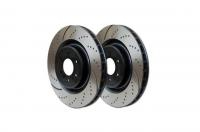
As it can be distinguished from the name, these types of discs include drills as well as slots. In addition to the preservation of the integrity, the heat, gas and water is extracted from them and the brake disc friction is consequently reduced.
Waved Edge Brake Discs
Before, these types of discs were used in motorcycle competitions. 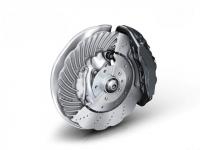 تصمیم به سرمایهگذاری روی دیسکهای موجدار گرفت. ابتدا آنها را در بعضی ازHowever, ten years ago, Audi decided to invest in the waved edge brake discs. First, used them for the supercars and then introduced the final waved edge brake disc to the world. As a result, the lighter weight of their ingredients, as well as the heat exportation of it, made it popular for other companies. The external surface of this disc has waved teeth, which include drills as well. Between the two surfaces, a little toothed surface is installed that increases the stability. Also, the two discs are only attached at the center.
تصمیم به سرمایهگذاری روی دیسکهای موجدار گرفت. ابتدا آنها را در بعضی ازHowever, ten years ago, Audi decided to invest in the waved edge brake discs. First, used them for the supercars and then introduced the final waved edge brake disc to the world. As a result, the lighter weight of their ingredients, as well as the heat exportation of it, made it popular for other companies. The external surface of this disc has waved teeth, which include drills as well. Between the two surfaces, a little toothed surface is installed that increases the stability. Also, the two discs are only attached at the center.
What is the alloy made for a brake disc?
A brake disc can be made of distinct materials. The only crucial element in these alloys is the ability to increase the heat level of the disc and reduce its depreciation against constant contact.
The used elements in the disc ingredient are as follows:
- Carbon ceramics
- Stainless still
- Titanium alloys
- Aluminum Matrix Composite
Each of these materials can be used to produce a disc, depending on the functionality and the manufacturer’s discretion.
Carbon Ceramic
The carbon ceramic-made discs have the best heat coefficient. This material has the best function in quick braking with the least probability of bending or alteration. Another feature of these discs is their ceramic composites. They usually have reinforced Silicone carabid, along with carbon fiber.
The pros of this type of disc are as follows:
- Braking system reinforcement
- Durability against the heat
- No welding needed
- Stability against erosion
Grey cast-iron
It is an alloy that has a low melting point and high capacity and it has a fine ability for mechanizing. Cast- iron discs are less expensive. Also, because of cast-iron features, it easily bears corrosion.
Titanium alloy
A titanium brake disc is of high quality, just like carbon ceramics, but their production cost is also higher. That’s why they are used in supercars and luxury vehicles. Titanium discs have an excellent stability and very light-weighted.
Aluminum discs
Aluminum discs have a long useful life, are lightweight, and suitable heat transfer coefficient. The low density of aluminum discs makes the final brake disc way lighter than other discs.
Also, these discs have a higher heat transfer than other brake disc types. It’s also worth knowing that on special occasions, like high velocity or carrying too much weight, they have the best income,
However, aluminum brake discs have little stability.
Nowadays, stainless still discs are more in use than other types, as they have all the features of a proper brake disc in addition to the fact that their ingredients are accessible at all times. The pros of this type of disc are as follows:
- Stability in high levels of heat
- Durability against corrosion
- Weldability
- Controllable heat
Also, still brake discs have fine stability and their production cost is low as well.
